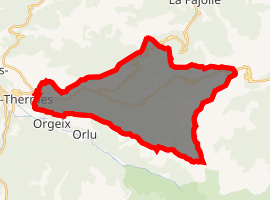Ascou
Ascou is a commune in the Ariège department in the Occitanie region of south-western France.
Ascou | |
|---|---|
The Étang de Goulours | |
Location of Ascou 
| |
 Ascou  Ascou | |
| Coordinates: 42°43′20″N 1°51′45″E | |
| Country | France |
| Region | Occitanie |
| Department | Ariège |
| Arrondissement | Foix |
| Canton | Haute-Ariège |
| Intercommunality | CC Haute-Ariège |
| Government | |
| • Mayor (2014-2020) | Claude Carrière |
| Area 1 | 35.59 km2 (13.74 sq mi) |
| Population (2017-01-01)[1] | 121 |
| • Density | 3.4/km2 (8.8/sq mi) |
| Time zone | UTC+01:00 (CET) |
| • Summer (DST) | UTC+02:00 (CEST) |
| INSEE/Postal code | 09023 /09110 |
| Elevation | 879–2,360 m (2,884–7,743 ft) (avg. 1,005 m or 3,297 ft) |
| 1 French Land Register data, which excludes lakes, ponds, glaciers > 1 km2 (0.386 sq mi or 247 acres) and river estuaries. | |
The inhabitants of the commune are known as Ascounais.[2]
Geography
Ascou is an alpine commune located some 40 km south-east of Foix and immediately east of Ax-les-Thermes. The northern border of the commune is the border between the departments of Ariège and Aude. Access to the commune is by the D 25 road which branches off the D 613 east of Ax-les-Thermes and continues through the village and the length of the commune to Mijanès over the mountains to the east. The D 258 road branches off the D 25 in the commune and goes north-east changing to the D 107 at the border and continuing to La Fajolle. Apart from the village there are the hamlets of Goulours, Lavail, and Pujal. The commune is entirely alpine in nature with no farmland.[3]
The Ruisseau de l'Adorre rises in the east of the commune and flows west gathering tributaries and changing to the Lauze river before passing the village and continuing west to join the Ariège at Ax-les-Thermes. The Ruisseau de l'Eycherque rise in the north-east of the commune and flows south-west to join the Lauze at the D 25 road. The Riu Caud flows from the north to join the Lauze at the Étang de Goulours[3]
Neighbouring communes and villages[3]
Administration
List of Successive Mayors[4]
| From | To | Name | Party | Position |
|---|---|---|---|---|
| 2001 | 2020 | Claude Carrière | PS |
(Not all data is known)
Demography
In 2010 the commune had 139 inhabitants. The evolution of the number of inhabitants is known from the population censuses conducted in the commune since 1793. From the 21st century, a census of communes with fewer than 10,000 inhabitants is held every five years, unlike larger towns that have a sample survey every year.[Note 1]
| 1793 | 1800 | 1806 | 1821 | 1831 | 1836 | 1841 | 1846 | 1851 |
|---|---|---|---|---|---|---|---|---|
| 776 | 613 | 851 | 914 | 925 | 1,001 | 837 | 842 | 805 |
| 1856 | 1861 | 1866 | 1872 | 1876 | 1881 | 1886 | 1891 | 1896 |
|---|---|---|---|---|---|---|---|---|
| 686 | 710 | 695 | 664 | 641 | 565 | 620 | 521 | 521 |
| 1901 | 1906 | 1911 | 1921 | 1926 | 1931 | 1936 | 1946 | 1954 |
|---|---|---|---|---|---|---|---|---|
| 469 | 456 | 453 | 363 | 310 | 266 | 250 | 274 | 158 |
| 1962 | 1968 | 1975 | 1982 | 1990 | 1999 | 2006 | 2010 | - |
|---|---|---|---|---|---|---|---|---|
| 136 | 114 | 120 | 81 | 96 | 102 | - | 139 | - |

Sites and monuments
The Parish Church contains a Statue of the Virgin and child![]()
Notable people linked to the commune
- Michel Naudy, journalist and politician.
See also
External links
- Ascou on the IGN website (in French)
- Ascou on Géoportail, National Geographic Institute (IGN) website (in French)
- Ascou on the 1750 Cassini Map
Notes and references
Notes
- At the beginning of the 21st century, the methods of identification have been modified by Law No. 2002-276 of 27 February 2002 Archived 6 March 2016 at the Wayback Machine, the so-called "law of local democracy" and in particular Title V "census operations" allows, after a transitional period running from 2004 to 2008, the annual publication of the legal population of the different French administrative districts. For communes with a population greater than 10,000 inhabitants, a sample survey is conducted annually, the entire territory of these communes is taken into account at the end of the period of five years. The first "legal population" after 1999 under this new law came into force on 1 January 2009 and was based on the census of 2006.
References
- "Populations légales 2017". INSEE. Retrieved 6 January 2020.
- Inhabitants of Ariège (in French)
- Google Maps
- List of Mayors of France (in French)
- Ministry of Culture, Palissy PM09000035 Statue: Virgin and Child (in French)
| Wikimedia Commons has media related to Ascou. |